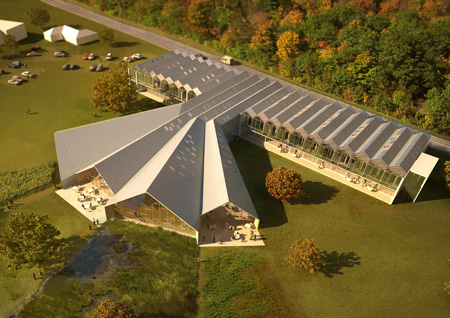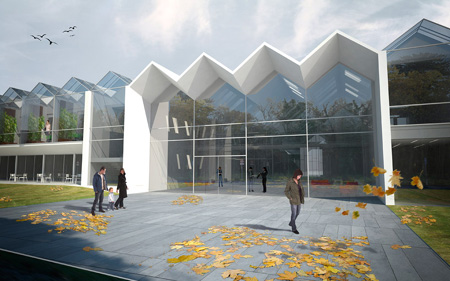The U.S. Green Building Council’s Leadership in Energy and Environmental Design (LEED) standards have come a long way in inspiring architects and building managers across the U.S. and around the world to save cash and carbon with eco-friendly design. But those standards were designed to improve current practices, rather than shift the whole paradigm of how we put buildings together in the first place.
Recently, we’ve seen some green building standards that push the envelope, so to speak — most notably, the Net Zero Energy Building Certification, which challenges home designers to create buildings that produce as much energy as they consume and treat all of their wastewater on site. But that standard was developed in the U.S., by the Cascadia chapter of the U.S. Green Building Council. Can it come as any surprise that clean, green Denmark has gone us one better, with a building built entirely around cradle-to-cradle materials?

The Green Solution House conference center and hotel, on the island of Bornholm, was designed to function as a platform for the highest level of sustainable development. Toward that end, all materials used in the building are either fully recyclable or biodegradable. Also — a key feature to making good on that promise of cradle to cradle design — the building itself was designed for easy disassembly at the end of its natural life.
Should the building’s managers apply for Net Zero Energy Building Certification, this building would seem to be an excellent candidate, as a solar photovoltaic system covers 100 percent of the building’s energy needs. The building also collects rain water, cleans it up via biological systems, and reuses this water for various applications. Green houses located on site — integrated into the building’s architecture — produce organic fruits and vegetables for the hotel restaurant, and all daily material flows from running the center are either recycled or composted.
Did you miss that? Here it is again: this hotel and restaurant produces no waste. Zilch. Zero. Designboom reports that this experimental hotel and meeting space was designed to give guests an idea of what it feels like to live “in a world without waste.”

Another noteworthy aspect of the Green Solution House is that it features the latest in sustainable technology, and always will. This means that the center is a project that will be under continuous development, and as the newest sustainable solutions in areas such as biodiversity, materials, energy, water and waste become available, they will be introduced into existing systems in the building.
The Green Solution House was designed by 3XN, an architecture firm in Copenhagen with a mission develop “a building culture that positively affects the world in which we live – both architecturally and environmentally.” The firm employs a network-based innovation method where design solutions often emerge from multidisciplinary expertise, paving the way for collaboration between professionals with different areas of expertise in sustainable design and building.
More on the Green Solution House can be found online, on the firm’s website.